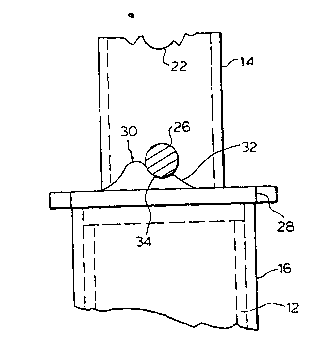Une partie des informations de ce site Web a été fournie par des sources externes. Le gouvernement du Canada n'assume aucune responsabilité concernant la précision, l'actualité ou la fiabilité des informations fournies par les sources externes. Les utilisateurs qui désirent employer cette information devraient consulter directement la source des informations. Le contenu fourni par les sources externes n'est pas assujetti aux exigences sur les langues officielles, la protection des renseignements personnels et l'accessibilité.
L'apparition de différences dans le texte et l'image des Revendications et de l'Abrégé dépend du moment auquel le document est publié. Les textes des Revendications et de l'Abrégé sont affichés :
| (12) Demande de brevet: | (11) CA 2138795 |
|---|---|
| (54) Titre français: | RONDELLE A ACTION RAPIDE, POUR POTEAU D'ETAYAGE |
| (54) Titre anglais: | QUICK RELEASE WASHER FOR A SHORING POST |
| Statut: | Réputée abandonnée et au-delà du délai pour le rétablissement - en attente de la réponse à l’avis de communication rejetée |
| (51) Classification internationale des brevets (CIB): |
|
|---|---|
| (72) Inventeurs : |
|
| (73) Titulaires : |
|
| (71) Demandeurs : | |
| (74) Agent: | GOWLING WLG (CANADA) LLP |
| (74) Co-agent: | |
| (45) Délivré: | |
| (86) Date de dépôt PCT: | 1994-04-25 |
| (87) Mise à la disponibilité du public: | 1994-11-10 |
| Licence disponible: | S.O. |
| Cédé au domaine public: | S.O. |
| (25) Langue des documents déposés: | Anglais |
| Traité de coopération en matière de brevets (PCT): | Oui |
|---|---|
| (86) Numéro de la demande PCT: | PCT/CA1994/000197 |
| (87) Numéro de publication internationale PCT: | WO 1994025705 |
| (85) Entrée nationale: | 1994-12-21 |
| (30) Données de priorité de la demande: | ||||||
|---|---|---|---|---|---|---|
|
2138795 9425705 PCTABS00034
A shoring post (10) comprises a support post (12) slidingly
engaging a telescoping sleeve member (14) and a screw device for
incrementally adjusting the length of the shoring post. The
telescoping member (14) having a plurality of pairs of diametrically
opposed holes spaced therealong. A pin member (26) for inserting
through a pair of the diametrically opposed holes of the telescoping
member to releasably extend the shoring post. A quick release
washer (28) for quickly reducing an overall length of the shoring
post. The washer (28) comprising a ring portion having a pair of
diametrically opposed cam lobes (30). The lobes having an inclined
surface (32), a cradling surface (34) and a stop. The washer (28)
is mounted between the pin (26) and the support post (12). The
washer has a load transfer position wherein the pin is cradled
between the cradling surface and the stop surface and a quick release
position whereby as the washer is rotated relative to the pin,
the pin travels along the inclined surface reducing the overall
length of the shoring post.
Note : Les revendications sont présentées dans la langue officielle dans laquelle elles ont été soumises.
Note : Les descriptions sont présentées dans la langue officielle dans laquelle elles ont été soumises.

2024-08-01 : Dans le cadre de la transition vers les Brevets de nouvelle génération (BNG), la base de données sur les brevets canadiens (BDBC) contient désormais un Historique d'événement plus détaillé, qui reproduit le Journal des événements de notre nouvelle solution interne.
Veuillez noter que les événements débutant par « Inactive : » se réfèrent à des événements qui ne sont plus utilisés dans notre nouvelle solution interne.
Pour une meilleure compréhension de l'état de la demande ou brevet qui figure sur cette page, la rubrique Mise en garde , et les descriptions de Brevet , Historique d'événement , Taxes périodiques et Historique des paiements devraient être consultées.
| Description | Date |
|---|---|
| Réputée abandonnée - omission de répondre à un avis sur les taxes pour le maintien en état | 2002-04-25 |
| Demande non rétablie avant l'échéance | 2002-04-25 |
| Inactive : Morte - RE jamais faite | 2002-04-25 |
| Inactive : Abandon.-RE+surtaxe impayées-Corr envoyée | 2001-04-25 |
| Inactive : Lettre officielle | 1999-05-04 |
| Inactive : Demande ad hoc documentée | 1997-04-25 |
| Réputée abandonnée - omission de répondre à un avis sur les taxes pour le maintien en état | 1997-04-25 |
| Demande publiée (accessible au public) | 1994-11-10 |
| Date d'abandonnement | Raison | Date de rétablissement |
|---|---|---|
| 2002-04-25 | ||
| 1997-04-25 |
Le dernier paiement a été reçu le 2001-04-12
Avis : Si le paiement en totalité n'a pas été reçu au plus tard à la date indiquée, une taxe supplémentaire peut être imposée, soit une des taxes suivantes :
Veuillez vous référer à la page web des taxes sur les brevets de l'OPIC pour voir tous les montants actuels des taxes.
| Type de taxes | Anniversaire | Échéance | Date payée |
|---|---|---|---|
| TM (demande, 4e anniv.) - générale | 04 | 1998-04-27 | 1998-04-24 |
| TM (demande, 5e anniv.) - générale | 05 | 1999-04-26 | 1999-04-19 |
| TM (demande, 6e anniv.) - générale | 06 | 2000-04-25 | 2000-04-19 |
| TM (demande, 7e anniv.) - générale | 07 | 2001-04-25 | 2001-04-12 |
Les titulaires actuels et antérieures au dossier sont affichés en ordre alphabétique.
| Titulaires actuels au dossier |
|---|
| GEORGE W. JACKSON |
| Titulaires antérieures au dossier |
|---|
| S.O. |